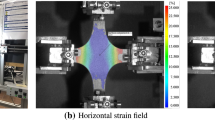Abstract
A two-scale parameter identification procedure to identify microscopic elastic parameters from macroscopic data is introduced and thoroughly analyzed. The macroscopic material behavior of microscopically linear elastic heterogeneous materials is described by means of numerical homogenization. The microscopic material parameters are assumed to be unknown and are identified from noisy macroscopic displacement data. Various examples of microscopically heterogeneous materials—with regularly distributed pores, particles, or layers—are considered, and their parameters are identified from different macroscopic experiments by means of a gradient-based optimization procedure. The reliability of the identified parameters is analyzed by their standard deviations and correlation matrices. It was found that the two-scale parameter identification works well for cellular materials, but has to be designed carefully for layered materials. If the homogenized macroscopic material behavior can be described by less material parameters than the microscopic material behavior, as, e.g., for regularly distributed particles, the identification of all microscopic parameters from macroscopic experiments is not possible.











Similar content being viewed by others
References
Ainsworth, M.: Essential boundary conditions and multi-point constraints in finite element analysis. Comput. Methods Appl. Mech. Eng. 190(48), 6323–6339 (2001)
Avril, S., Grédiac, M., Pierron, F.: Sensitivity of the virtual fields method to noisy data. Comput. Mech. 34(6), 439–452 (2004)
Bakhtiari-Nejad, F., Rahai, A., Esfandiari, A.: A structural damage detection method using static noisy data. Eng. Struct. 27(12), 1784–1793 (2005)
Becker, R., Vexler, B.: A posteriori error estimation for finite element discretization of parameter identification problems. Numer. Math. 96(3), 435–459 (2004)
Bensoussan, A., Lions, J.L., Papanicolaou, G.: Asymptotic methods in periodic structures. Stud. Math. Appl. 5 (1978)
Bocciarelli, M., Bolzon, G., Maier, G.: Parameter identification in anisotropic elastoplasticity by indentation and imprint mapping. Mech. Mater. 37(8), 855–868 (2005)
Bruhns, O., Anding, D.: On the simultaneous estimation of model parameters used in constitutive laws for inelastic material behaviour. Int. J. Plast. 15(12), 1311–1340 (1999)
Fedele, R., Maier, G., Whelan, M.: Stochastic calibration of local constitutive models through measurements at the macroscale in heterogeneous media. Comput. Methods Appl. Mech. Eng. 195(37–40), 4971–4990 (2006)
Feyel, F., Chaboche, J.L.: \(\text{ FE }^2\) multiscale approach for modelling the elastoviscoplastic behaviour of long fibre sic/ti composite materials. Comput. Methods Appl. Mech. Eng. 183(3–4), 309–330 (2000)
Gavrus, A., Massoni, E., Chenot, J.: An inverse analysis using a finite element model for identification of rheological parameters. J. Mater. Process. Technol. 60(1), 447–454 (1996)
Gross, D., Seelig, T.: Bruchmechanik : Mit einer Einführung in die Mikromechanik, 5th edn. Springer, New York (2011)
Haddadi, H., Belhabib, S.: Improving the characterization of a hardening law using digital image correlation over an enhanced heterogeneous tensile test. Int. J. Mech. Sci. 62(1), 47–56 (2012)
Hill, R.: Elastic properties of reinforced solids: some theoretical principles. J. Mech. Phys. Solids 11(5), 357–372 (1963)
Kelley, C.: Iterative Methods for Optimization. SIAM, Philadelphia (1995)
Kleiber, M.: Parameter Sensitivity in Nonlinear Mechanics. Wiley, Chichester (1997)
Klinge, S.: Inverse analysis for multiphase nonlinear composites with random microstructure. J. Multiscale Comput. Eng. 10, 361–373 (2012)
Kouznetsova, V.: Computational homogenization for the multi-scale analysis of multi-phase materials. Ph.D. thesis, Technical University Eindhoven (2002)
LLorca, J., Segurado, J.: Three-dimensional multiparticle cell simulations of deformation and damage in sphere-reinforced composites. Mater. Sci. Eng. A 365(1–2), 267–274 (2004)
Macconi, M., Morini, B., Porcelli, M.: Trust-region quadratic methods for nonlinear systems of mixed equalities and inequalities. Appl. Numer. Math. 59(5), 859–876 (2009)
Mahnken, R.: Theoretische und numerische Aspekte zur Modellierung und Parameteridentifikation bei metallischen Werkstoffen. Universität Hannover, Habilitation (1996)
Mahnken, R., Stein, E.: A unified approach for parameter identification of inelastic material models in the frame of the finite element method. Comput. Methods Appl. Mech. Eng. 136(3–4), 225–258 (1996)
Mandel, J.: Contribution téorique à l’étude de l’écrouissage et des lois de l’écoulement plastique. In: Applied Mechanics: Proceedings of the Eleventh International Congress of Applied Mechanics Munich (Germany) 1964, pp. 502–509 (1966)
Miehe, C.: Computational micro-to-macro transitions for discretized micro-structures of heterogeneous materials at finite strains based on the minimization of averaged incremental energy. Comput. Methods Appl. Mech. Eng. 192(5–6), 559–591 (2003)
Miehe, C., Koch, A.: Computational micro-to-macro transitions of discretized microstructures undergoing small strains. Arch. Appl. Mech. 72(4), 300–317 (2002)
Morini, B., Porcelli, M.: TRESNEI, a matlab trust-region solver for systems of nonlinear equalities and inequalities. Comput. Optim. Appl. 51, 27–49 (2012)
Oskay, C., Fish, J.: On calibration and validation of eigendeformation-based multiscale models for failure analysis of heterogeneous systems. Comput. Mech. 42, 181–195 (2008)
Reuß, A.: Berechnung der Fließgrenze von Mischkristallen auf Grund der Plastizitätsbedingung für Einkristalle. ZAMM J. Appl. Math. Mech. 9(1), 49–58 (1929)
Schmidt, U., Mergheim, J., Steinmann, P.: Multiscale parameter identification. Int. J. Multiscale Comput. Eng. 10(4), 327–342 (2012)
Schmidt, U., Mergheim, J., Steinmann, P.: Identification of elastoplastic microscopic material parameters within a homogenization scheme. Int. J. Numer. Meth. Eng. 104(6), 391–407 (2015)
Smit, R., Brekelmans, W., Meijer, H.: Prediction of the mechanical behavior of nonlinear heterogeneous systems by multi-level finite element modeling. Comput. Methods Appl. Mech. Eng. 155, 181–192 (1998)
Sukumar, N., Pask, J.E.: Classical and enriched finite element formulations for bloch-periodic boundary conditions. Int. J. Numer. Math. Eng. 77(8), 1121–1138 (2009)
Suquet, P.M.: Plasticity Today, Chap. Local and Global Aspects in the Mathematical Theory of Plasticity. Elsevier Applied Science Publishers, London (1985)
Voigt, W.: Über die Beziehung zwischen den beiden Elasticitätsconstanten isotroper Körper. Ann. Phys. 38, 573–587 (1889)
Xiao, Q.Z., Karihaloo, B.L.: Two-scale asymptotic homogenisation-based finite element analysis of composite materials. Multiscale Model. Solid Mech. Comput. Approaches 3, 43 (2009)
Acknowledgments
The authors would like to acknowledge the funding of the Deutsche Forschungsgemeinschaft (DFG) through the Cluster of Excellence Engineering of Advanced Materials.
Author information
Authors and Affiliations
Corresponding author
Rights and permissions
About this article
Cite this article
Schmidt, U., Steinmann, P. & Mergheim, J. Two-scale elastic parameter identification from noisy macroscopic data. Arch Appl Mech 86, 303–320 (2016). https://doi.org/10.1007/s00419-015-1096-2
Received:
Accepted:
Published:
Issue Date:
DOI: https://doi.org/10.1007/s00419-015-1096-2




